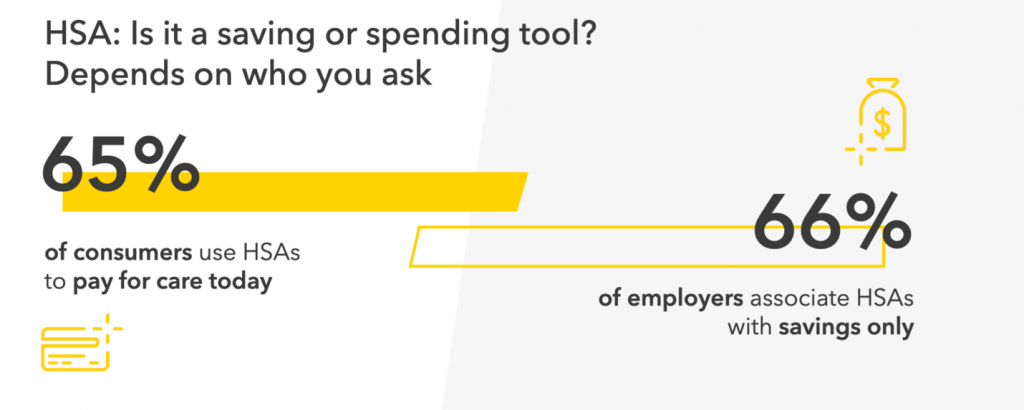Is a health savings account (HSA) a savings tool or a tool to pay for today’s rising healthcare costs? It depends on whom you ask. While HSAs were originally introduced to employees as a long-term investment tool that can also be used to pay for eligible medical expenses along the way, employees’ usage of the accounts has drastically shifted.

With healthcare costs continuing to rise in the United States, it is projected that by 2028, healthcare spending will reach $6.19 trillion, an increase of more than 19%. What’s more, it is estimated that medical goods and services will grow at an average annual rate of 2.4% from 2019 to 2028, accounting for 43% of the total projected growth in personal healthcare spending. As employees are faced with paying for costs today, they have pivoted their usage of their HSAs to meet this growing expense.
Employees want to be active participants in their health care. In fact, Further, a national health savings and spending account administrator, recently asked consumers why they selected a high-deductible health plan (HDHP) or consumer-directed health plan (CDHP), paired with an HSA, and over half of respondents said they want the ability to save money—not for investment purposes but for future or current healthcare needs.
How HSAs Have Evolved
In this same survey, employees also report that they associate benefits paired with HSAs as a “best value” option and a way to only pay for the services and care they need today.In otherwords, they view HSAs as a spending tool.
With only 30% of respondents leveraging at least a portion of their HSA accounts for tax savings benefits or as a savings tool, employers must pause and ask if the way they are positioning these accounts is in line with employee needs.
Employers must come to realize that a movement has occurred over the past few years, as noted above. Consumers are forced to find new ways to pay for today’s expenditures, and they’re turning to their HSAs to do so.
In fact, when asked if they use their HSA to pay for health care now or if they use their account for investment purposes, 65% responded that they spend their HSA dollars. Only 23% stated they use their account to save and spend equally.
Yet, more than 66% of employers position HSAs as savings or investment tools.

Closing the HSA Gap
If employers want to increase employees’ education around these accounts, they need to recognize this huge gap between how they are presenting HSAs versus how employees are actually leveraging them.
In other words, for employees to fully benefit from these accounts, employers must update their education, communications, and benefits materials. Here are nine ways employers can educate and empower employees to navigate their HSA and other health benefits this open enrollment season.
- Mainstream language: Avoid using industry acronyms, and make information available early in the open enrollment process.
- Use visual aids: Bring the information to life through charts, graphs, and videos, and make it available on a dedicated intranet.
- Show cost comparisons: By showing employees examples of paying for care, with and without an HSA, employees can visualize the savings associated with using pretax dollars for eligible medical expenses.
- Communicate beyond open enrollment: Create an ongoing communication plan that breaks down benefit topics each month, allowing employees to dive deeper into subjects and ask questions throughout the year.
- Promote telehealth appointments: They are often the least expensive way to diagnose and treat routine illnesses while saving time.
- Provide shopping support: Quality decision support tools enable employees to compare costs among different healthcare facilities, as well as prescription costs from different pharmacies. Such comparison tools can help plan participants avoid surprise bills.
- Navigate prescriptions: Encourage employees to ask for generic drugs and 90-day supplies, when appropriate. Promoting prescription apps can also result in savings.
- Treatment options: Encourage employees to talk with their healthcare providers about their CDHP and treatment options, which could result in doctors recommending alternative, less expensive procedures.
- Ongoing communication: Continue communicating about the HSA throughout the year. Conduct post-enrollment meetings to answer questions about HSAs and to address specific claim situations employees might have encountered.
Over the past few years, employee usage of HSAs has shown a pattern of spending. Ask yourself: Is your company still mostly positioning them as a savings tool? And, in light of the fact that 63% of employees report they now pay more attention to their healthcare benefits, employers can keep this employee engagement going into open enrollment.
By moving to presenting HSAs as a savings AND spending tool, employees will value their benefits more, resulting in increased benefits adoption and healthier employee populations.

Matt Marek is CEO and President of Further, a provider in health spending and savings account administration dedicated to guiding account holders across the United States in saving and spending wisely on their health care. Further serves large corporations, small businesses, labor unions, retirees, and groups in the public sector by providing HSAs, flexible spending accounts (FSAs), health reimbursement arrangements (HRAs), voluntary employee beneficiary association (VEBA) accounts, and commuter benefit services. Visit hellofurther.com for more information.
The content, research, and recommendations in this article are provided “AS IS” and intended for informational purposes only and should not be relied on for legal, operational, tax, or other advice. The actual benefits and costs of any programs may vary based on individual program requirements and business needs.
